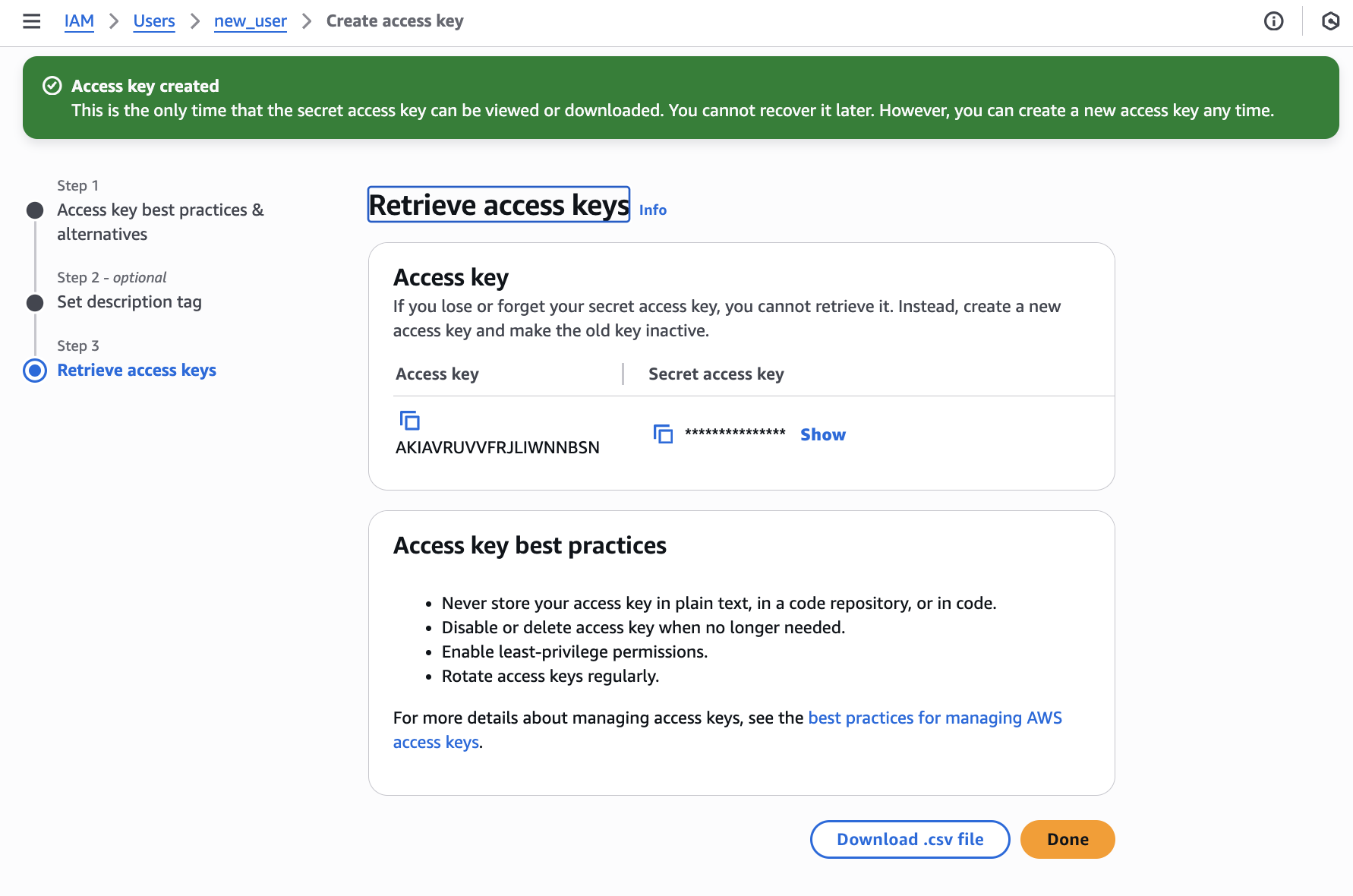Amazon Web Services (AWS)
Why should you use Defang with AWS? Defang allows you to easily create and manage full, scalable applications with AWS. Defang aims to make it easier to deploy your services to the cloud. Don't waste your time learning the ins and outs of AWS, deciding which of the 200+ services to use, and then writing the infrastructure code to deploy your services, and making sure they are properly secured. Defang does all of that for you.
Getting Started
Getting started with the Defang BYOC AWS Provider is easy. The first step is to authenticate your shell with AWS as an admin user. The authenticated user should be an IAM admin because Defang will need permission to create resources and IAM roles in your account.
You can create other AWS users for deployment.
If you have the AWS CLI installed, you should be able to successfully run aws sts get-caller-identity and see your account ID.
Use the --provider=aws flag to tell the Defang CLI to use the AWS Provider or set the DEFANG_PROVIDER environment variable to aws.
$ defang compose up --provider=aws
# or
$ export DEFANG_PROVIDER=aws
Because Defang creates roles, you need to have the appropriate permissions to create roles in your cloud provider account, typically the AdministratorAccess policy in AWS.
The Defang CLI does not depend on the AWS CLI. It uses the AWS SDK for Go to interact with your AWS account. In most cases, if you can run the aws sts get-caller-identity from the tip above, you should be good to go. However, due to a difference between the AWS CLI and the AWS SDK for Go, there is at least one case where they behave differently: if you are using aws sso login and have clashing profiles in your .aws/config and .aws/credentials files, the AWS CLI will prioritize SSO profiles and caches over regular profiles, but the AWS SDK for Go will prioritize the credentials file, and it may fail.
Region
The Defang BYOC AWS Provider will use the region specified in the AWS_REGION environment variable, or a profile in the ~/.aws/config file exactly as the AWS CLI would.
Architecture
Defang uses resources that are native to the cloud provider you are using. The following describes the current state of Defang's support for AWS, the specific resources that Defang uses, and the roadmap for future support.
Secrets
Defang allows you to configure your services with sensitive config values. Sensitive values are stored in AWS Systems Manager Parameter Store, and are encrypted.
Deployment
To deploy your services, the Defang CLI packages your code and uploads it to an S3 bucket in your account. The CLI then deploys an ECS task that uses Pulumi to build your container image and run your service.
Runtime
The provider runs your workloads using ECS using Fargate. It provisions a VPC with public and private subnets, and deploys your services to the private subnets. It then provisions an Application Load Balancer (ALB) and routes traffic to your services.
Service Discovery
Defang uses a Route53 private hosted zone for service discovery. Each (private) service in the Compose file will get a CNAME or A record which resolves to the service's AWS domain name or IP, respectively. To update the A records for the dynamically assigned IP addresses, Defang will add a Route53 sidecar alongside your container.
Managed Storage
Defang can help you provision managed storage services. The following managed storage services are supported on AWS:
Managed Postgres
When using Managed Postgres, the Defang CLI provisions an RDS Postgres instance in your account.
Managed Redis
When using Managed Redis, the Defang CLI provisions an ElastiCache Redis cluster in your account.
Managed LLMs
Defang offers integration with managed, cloud-native large language model services with the x-defang-llm service extension. Add this extension to any services which use the Bedrock SDKs.
When using Managed LLMs, the Defang CLI provisions an ElastiCache Redis cluster in your account.
Managed MongoDB
Defang will provision a DocumentDB instance for services that use the x-defang-mongodb service extension. This allows you to use MongoDB as a managed service, rather than running it as a container.
Managed Resources
Defang will create and manage the following resources in your AWS account from its bootstrap CloudFormation template:
| Resource Type | Example Resource Name |
|---|---|
| s3/Bucket | defang-cd-bucket-cbpbzz8hzm7 |
| ecs/ClusterCapacityProviderAssociations | defang-cd-Cluster-pqFhjwuklvm |
| ecs/Cluster | defang-cd-ClusterpJqFhjwuklvm |
| iam/Role | defang-cd-ExeutionRole-XE7RbQDfeEwx |
| ec2/InternetGateway | igw-05bd7adc92541ec3 |
| ec2/VPCGatewayAttachment | IGW |
| logs/LogGroup | defang-cd-Logroup-6LSZet3tFnEy |
| ecr/PullThroughCacheRule | defang-cd-ecrpublic |
| ec2/Route | rtb-08f3f5afc9e6c8c8 |
| ec2/RouteTable | rtb-08f3f5ffc9e6c8c8 |
| ec2/VPCEndpoint | vpce-02175d8d4f47d0c9 |
| ec2/SecurityGroup | sg-032b839c63e70e49 |
| ec2/Subnet | subnet-086bead399ddc8a0 |
| ec2/SubnetRouteTableAssociation | rtbassoc-02e200d45e7227fe |
| ecs/TaskDefinition | arn:aws:ecsus-west-2:381492210770:task-definition/defang-cd-TaskDefinition-RXd5tf9TaN38:1 |
| iam/Role | defang-cd-askRole-gsEeDPd6sPQY |
| ec2/VPC | vpc-0cbca64f13435695 |
Then, for each project you deploy, Defang will create and manage the following resources:
| Resource Type | Example Resource Name |
|---|---|
| ecr/Repository | project1/kaniko-build |
| ecr/LifecyclePolicy | project1/kaniko-build |
| acm/Certificate | *.project1.tenant1.defang.app |
| ecr/Repository | project1/kaniko-build/cache |
| ecr/LifecyclePolicy | project1/kaniko-build/cache |
| iam/InstanceProfile | ecs-agent-profile |
| iam/Role | ecs-task-execution-role |
| cloudwatch/EventRule | project1-ecs-lifecycle-rule |
| cloudwatch/EventTarget | project1-ecs-event-cw-target |
| route53/Record | validation-project1.tenant1.defang.app |
| acm/CertificateValidation | *.project1.tenant1.defang.appValidation |
| ec2/VpcDhcpOptionsAssociation | dhcp-options-association |
| cloudwatch/LogGroup | builds |
| iam/Role | kaniko-task-role |
| ecs/TaskDefinition | kanikoTaskDefArm64 |
| ecs/TaskDefinition | kanikoTaskDefAmd64 |
| s3/Bucket | defang-build |
| s3/BucketPublicAccessBlock | defang-build-block |
| ecs/Cluster | cluster |
| ecs/ClusterCapacityProviders | cluster-capacity-providers |
| ec2/SecurityGroup | project1_app-sg |
| ec2/SecurityGroup | bootstrap |
| ec2/VpcDhcpOptions | dhcp-options |
| cloudwatch/LogGroup | logs |
Creating an AWS IAM User for Defang
To deploy applications with Defang on AWS, you need an IAM user with appropriate permissions and access keys. This guide walks you through the process step by step.
Step 1: Create an IAM User
a. Open the IAM Service
Go to the IAM Users Panel.
b. Click Create User
Click the Create user button at the top right.
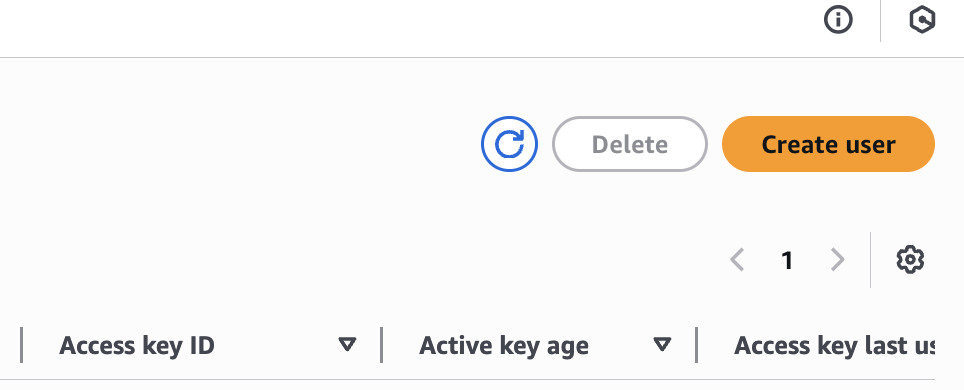
c. User details
Enter a user name, and assign permissions. Defang requires the PowerUserAccess policy in order to deploy and manage resources in your account.
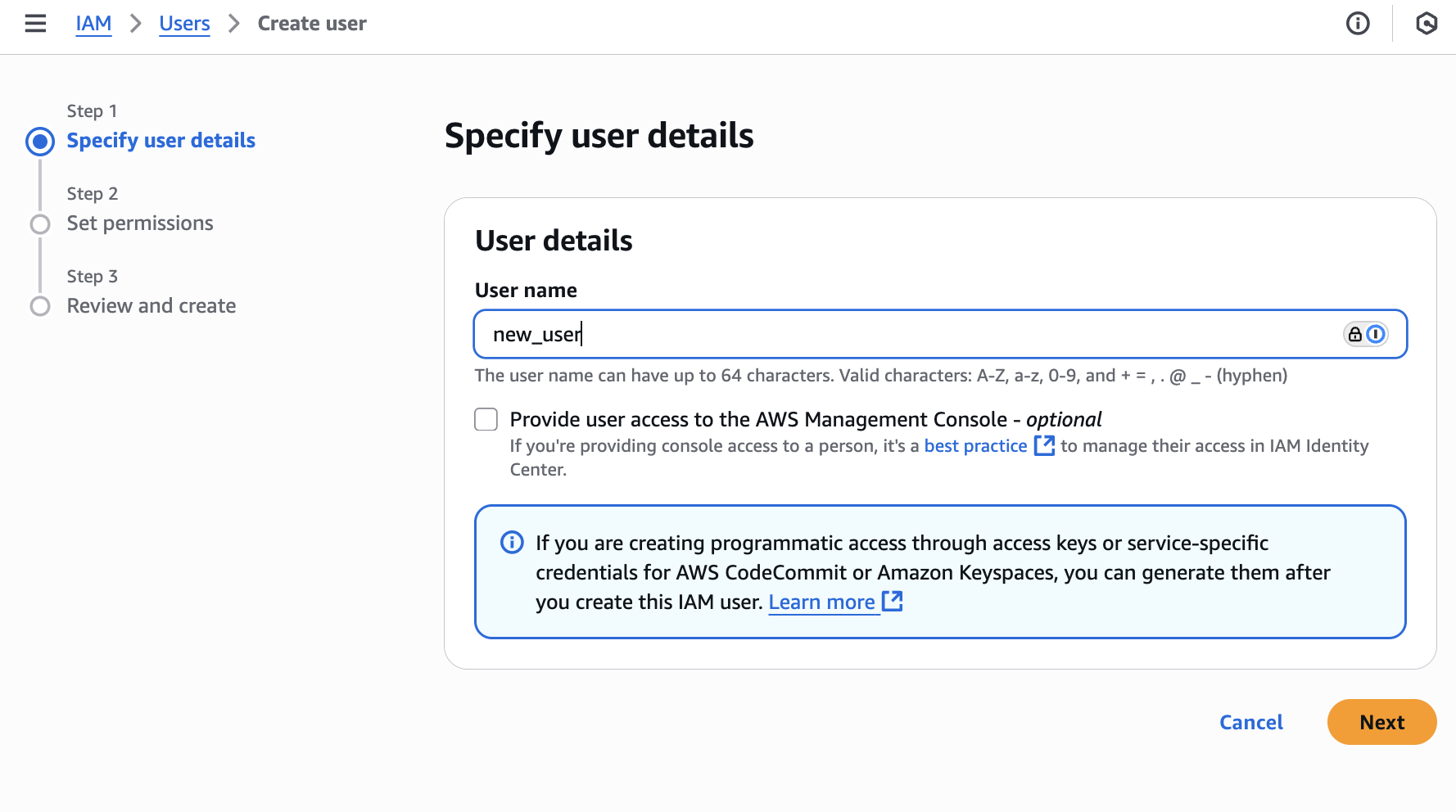
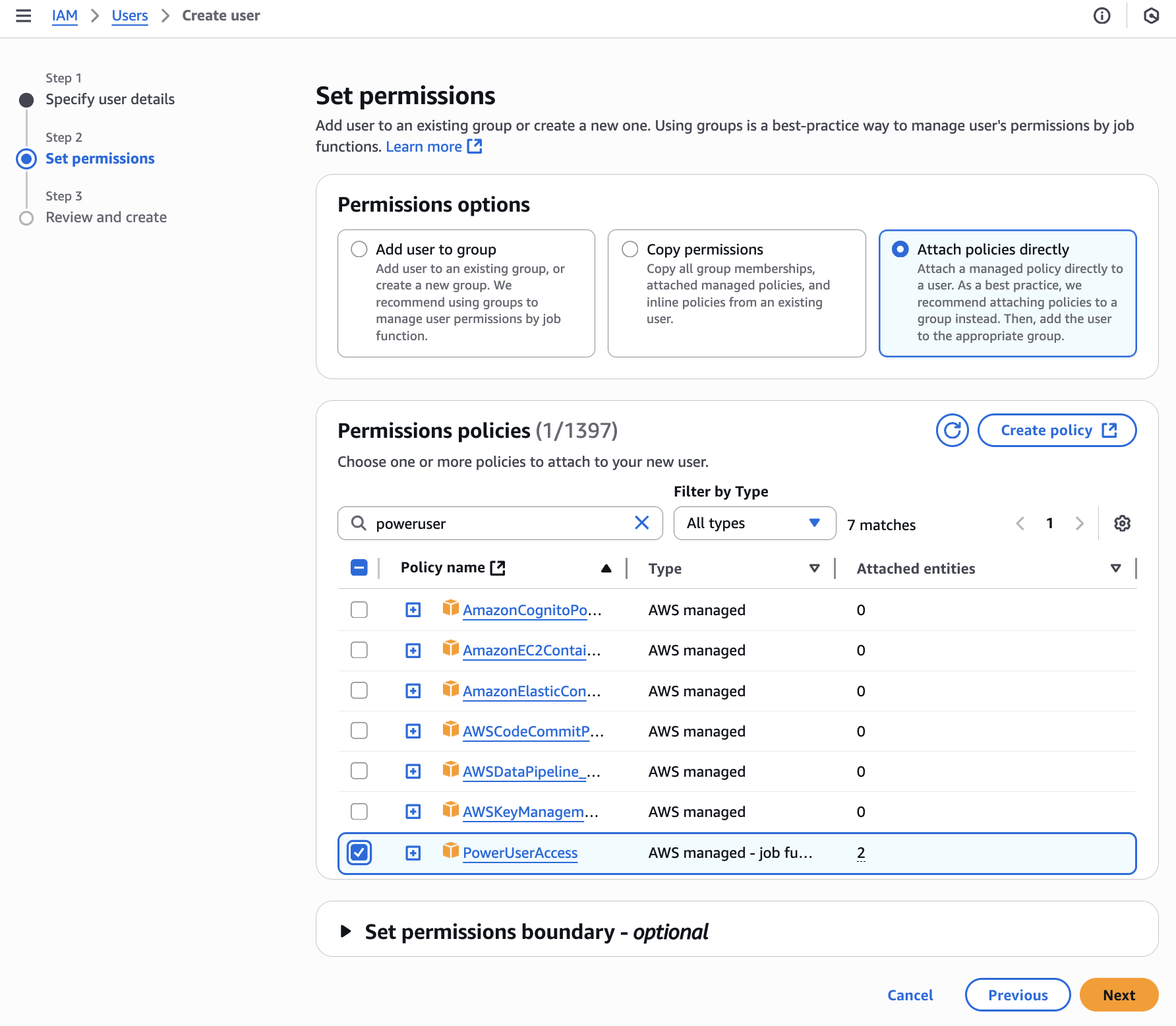
d. Review and Confirm
Review your settings and confirm the creation of the user.
Step 2: Create Access Keys
Access keys are the easiest way to authorize programmatic access to AWS. Follow these steps to create them:
a. Select the New User
After creating the user, locate them in the IAM Users Panel and select the user.

b. Create Access Key
In the User Summary panel, click Create access key.

c. Select Use Case
For Defang, select the use case "Application running on AWS compute service".
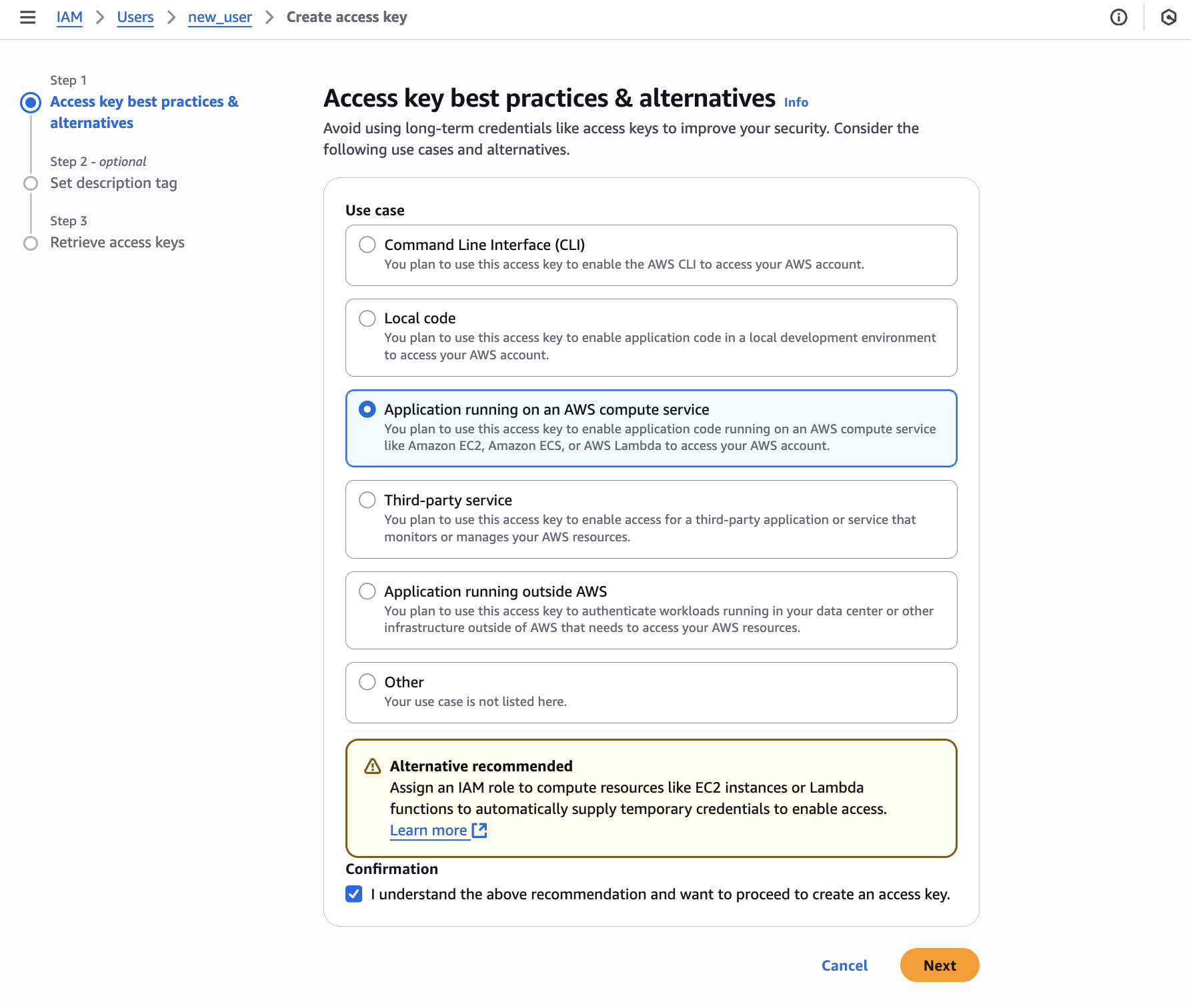
d. Add Description and Continue
Optionally, provide a description for the key and click Next.
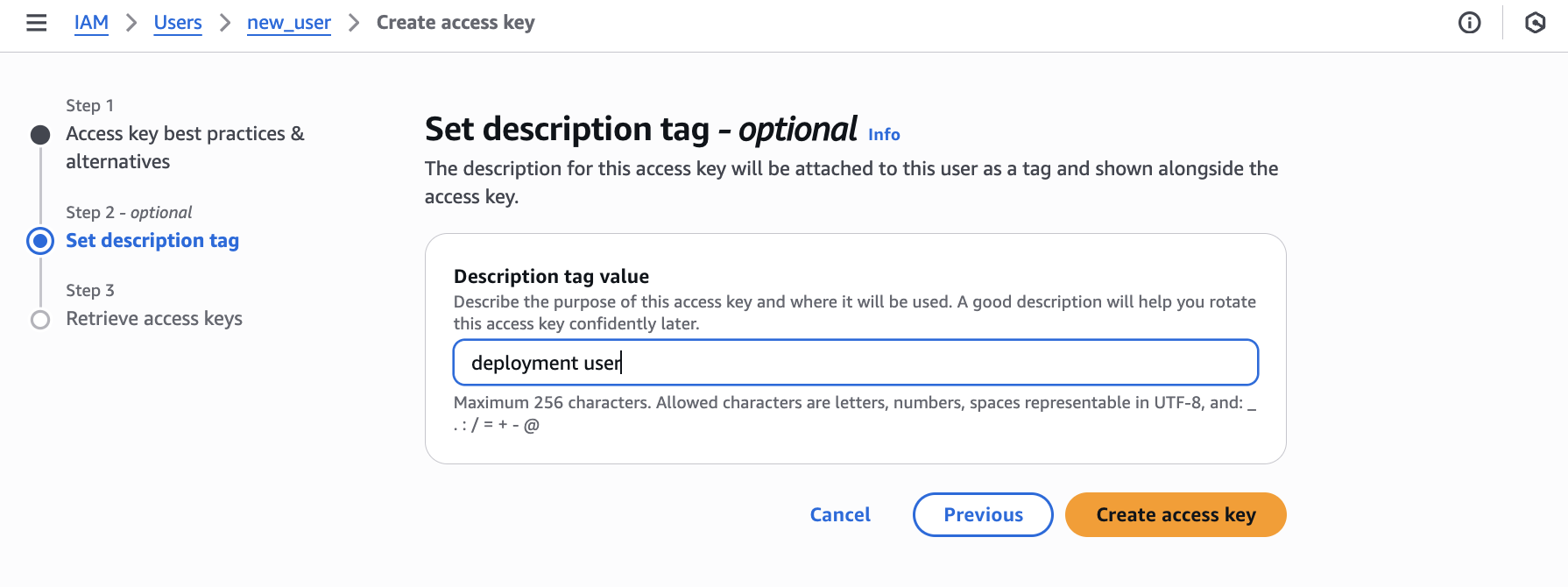
e. Save Your Access Keys
Your new access key will be generated. Copy and save the Access Key ID and Secret Access Key—you will need these for Defang deployments.
